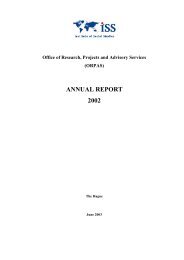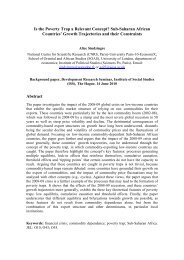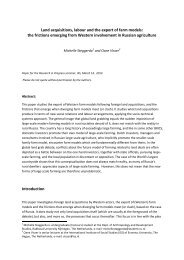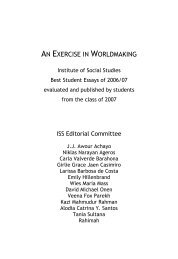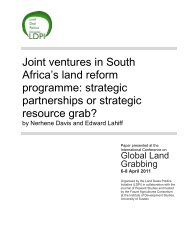AN EXERCISE IN WORLDMAKING 2009 - ISS
AN EXERCISE IN WORLDMAKING 2009 - ISS
AN EXERCISE IN WORLDMAKING 2009 - ISS
You also want an ePaper? Increase the reach of your titles
YUMPU automatically turns print PDFs into web optimized ePapers that Google loves.
17 Intersectionality and Human Rights: Law, Theory and Praxis 207<br />
about inclusivity, power and privilege, as well as access to constructive<br />
spaces and “voice” within these spaces, it is important to consider where<br />
– geographically and conceptually – the theoretical debates on intersectionality<br />
occur. It is crucial to reflect on how it is currently framed and its<br />
applicability to other contexts. For example, Crenshaw has prominently<br />
explored violence against women in the US through the lens of intersectionality,<br />
arguing that the lack of attention to how race and gender intersect<br />
has rendered US policy and practice ineffective with regard to violence<br />
against women of colour (1991, 1993). Other feminists have<br />
followed suit with an increasing volume of feminist literature on the<br />
need to incorporate intersectionality by looking at how race, language,<br />
social class and other issues of identity politics come to bear on the way<br />
that women experience violence.<br />
How applicable is this growing body of literature, however, to other<br />
contexts? I have written elsewhere about how gender-based violence and<br />
sexual violence against women in South Africa are often addressed by<br />
the government and some civic organisations as if these have nothing to<br />
do with gender (De Nobrega 2008). Instead, the focus has tended to be<br />
on how violence against women is “really” about class (poverty) and racial<br />
discrimination (apartheid), or an effect of the devolution of the family<br />
unit which is resulting in moral decay and social disorder. There is<br />
little or no recognition of how gender inequality, and hegemonic discourses<br />
on gender identity and sexuality, are at the root of this violence.<br />
The case of South Africa is therefore the complete opposite of examples<br />
in the mainstream writing on intersectionality that is emerging on<br />
Europe and the US.<br />
Does this mean that intersectionality is merely a useful concept for<br />
the North? No. On the contrary, the strength of intersectionality is that<br />
it allows rights-based feminist writers to recognise their own location and<br />
their positions of power and privilege with regard to other women (and<br />
even men), without needing to abandon the entire feminist project altogether<br />
for fears that their views are somehow compromised because they<br />
are not on the “bottom-rung” in terms of oppression. It is not the case<br />
that someone who has “applied” an intersectional framework or analysis<br />
to a particular issue (such as gender oppression) is suddenly “freed” from<br />
her own framing and identity, but if she uses her “own social location…<br />
as an analytic resource” she may be more able to understand her location<br />
of oppression in relation to others (Davis 2008: 9). Intersectionality en-




